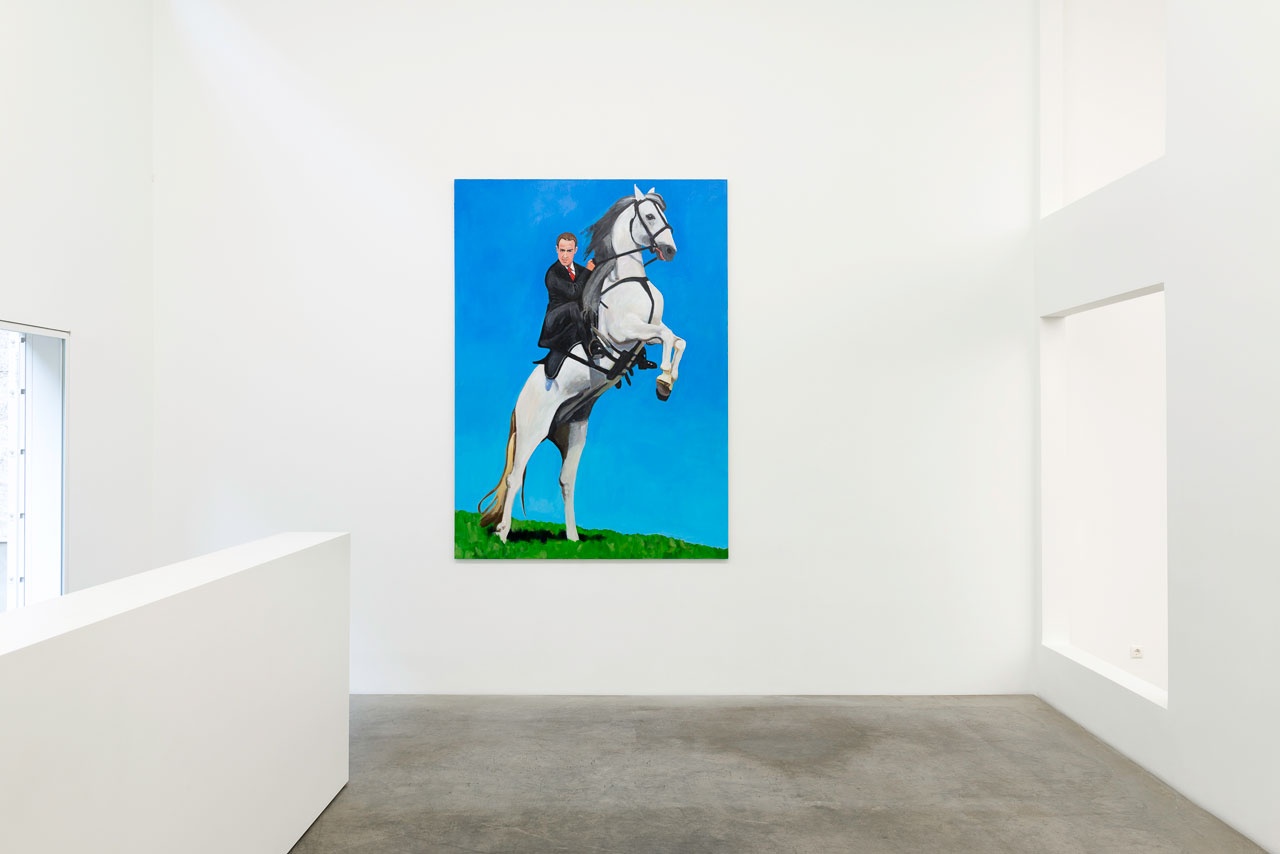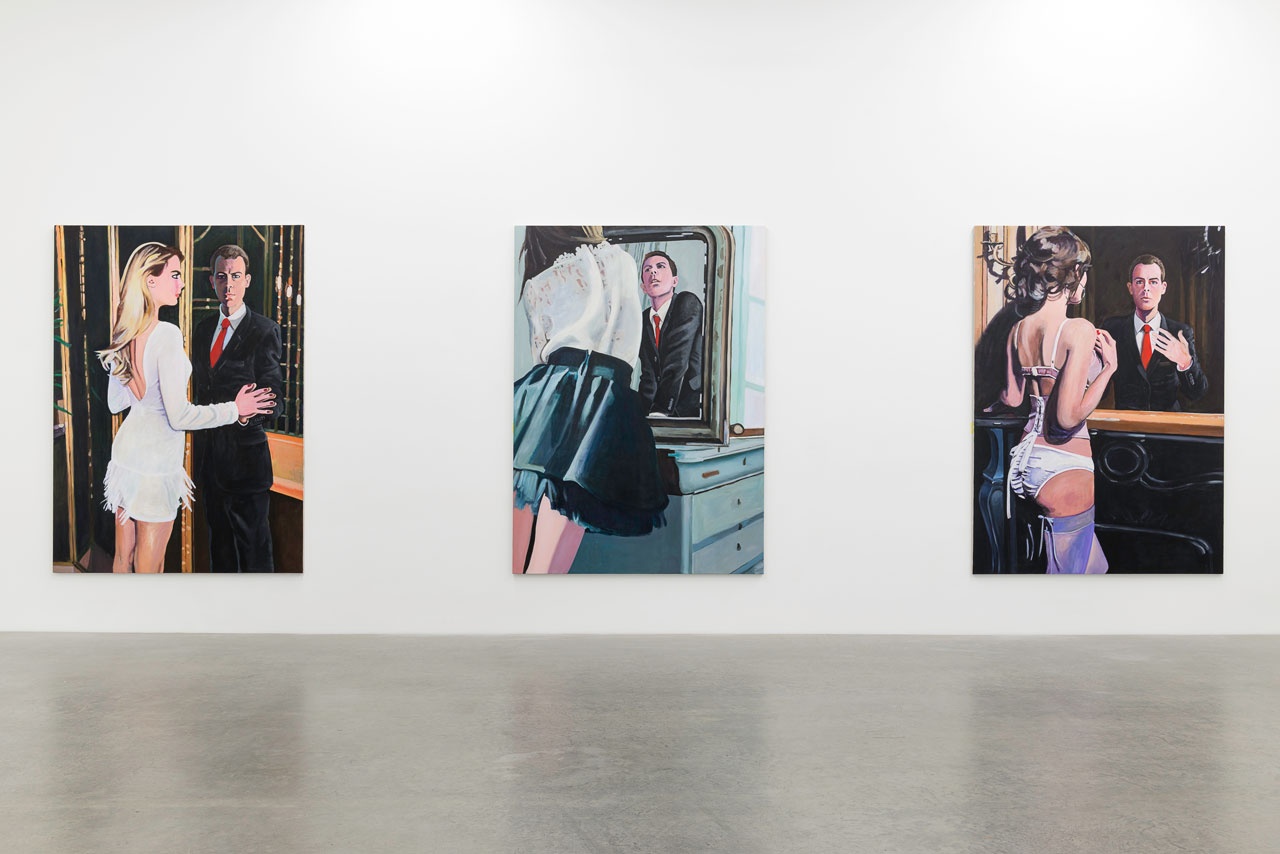THE MAN IN THE MIRROR Sarah Morris on Merlin Carpenter at Galerie Neu, Berlin

As an artist, I am continuously both the subject and the object – both a subject with an ongoing narrative, creating situations, making forms and experiences out of them; and an object , in as much as I make objects which are commodified, and as such am identified and placed by myself and others in a field of activity and meaning with histories. In that field, as with most, one loses control of the object and its possible meanings after it is made. Making this further complex I can, for instance, comment on Picabia while appearing to be “a Picabia” – a female “face” who is simultaneously an agent, an author, and a producer. This latter example, suggested to me at a museum dinner – a shared “deviousness” with the image of a Picabia girl – made me laugh. But these objects of art, these productions, always go back to the condition of having an author, of having been made with intention, a willpower; willed into the world with a deliberate provocation and contradiction. This is the Artist, this interesting movement between two states of being. It is this loop that I find endlessly, fascinatingly perverse, full of infinite play and interpretations.
My twin, my reflection, is real only insofar as it is a real projection. Michael Jackson’s “Man in the Mirror,” a naked Yves Saint Laurent selling his perfume in 1971, Alexander Kluge reading my script, talking back to me. What do I see when I look at my reflection? I do not see a man but perhaps I am thinking of one. The mental image of what I see and what is actually there ping-pongs back and forth. A mirror is a social equation, a thought about a future moment, a wish, a morphing self. A social space is imagined. In his summer show of six large works at Galerie Neu, Merlin Carpenter has returned to figurative painting to collapse the idea of reflection with the idea of the twin into the ideas of use value and contemplation on the existence of an “outside.”
 “Merlin Carpenter: Business Women,” Galerie Neu, Berlin, 2017, installation view
“Merlin Carpenter: Business Women,” Galerie Neu, Berlin, 2017, installation view
Reflection and twin – these are not the same but they do share some properties. To have a twin is not about seeing the same, but about a similarity of origin and a seeming similarity of direction or journey. Yet DNA mutates differently in each twin’s body and in fact systematically does so over a duration. We see this in Carpenter’s paintings. The businessman and his twin in the mirror: Capital configured as the theory of the young girl, its “vision machine.” Or is it the other way around? The jeune-fille mirrored by him? One in a skirt or lingerie, the other in a well-cut suit; the businessman using the female form, controlling her, and, reciprocally, she using him. It’s not clear who’s in control and that’s alright. It goes beyond gender, this slipperiness of the reflection. It goes beyond gender with the infinite ways Capital instructs all of us without exception. It’s not about lipstick. There is no desire in these paintings whatsoever. No coupling. No ideal. “Graham” as the businessman figure with his escort – or her with her capitalist – seems devoid of desire. In fact, the reflection never touches the real. Graham, in five of the six paintings, is accompanied, appearing in private or public scenes that are set in private or public (no difference to me) mirrored spaces, possibly hotel rooms or bathrooms, and yet she seems utterly oblivious to her “twin.” It could be argued that his purpose is her reflection. The Instagram come-on. It is transactional with no sex. If this seems a bad metaphor, it is; and it falls flat on purpose.
Desire in this equation, by absence, figures centrally in Carpenter’s show, revealing itself as the void. But the void desires; it is a vacuum, an empty space awaiting meaning – whether a room, a painting, a person, a gaze. What to make of a mark, a gesture, a character made in these spaces? A sign of acceptance? A warning? Some acts, whether creative or political, even if they are intended to carry certain meaning, instead effect a concrete void or meaninglessness, which is an altogether different order of emptiness. This is not the case when I look at Carpenter’s paintings, which are collectively titled “Business Women.” In these paintings, I see both consensus and affliction depicted through the “twins.”
We are all involved with the “business women.” That’s obvious now. But this fact makes Carpenter’s series no less perverse: paintings that picture the female gaze looking onto “herself” becoming a man who in turn embodies the rhetorical gaze of the viewer who is, meanwhile, consuming both. Multiple women and one man; a seemingly classic power structure. How many women have been the object of painting? How many “girls” sell the work (back to the delicious Picabia)? And who is this effete, corporate-suited “Graham,” seeing himself as a girl in a skirt or panties actively posing à la théorie de la jeune-fille ? This is fantasy. This is the controlled choreography of Capitalism. This is not desire. This is Carpenter presenting farce feeding itself to us, presenting Carpenter as the artist. If the girl is the subject in the act of looking at herself for others, she has been hijacked by this Tony Blair-looking businessman in the bathroom mirror; who does not dominate necessarily, but does manage to undermine the subject of our looking. We are complicit.
“Merlin Carpenter: Business Women,” Galerie Neu, Berlin, June 16–August 8, 2017.
